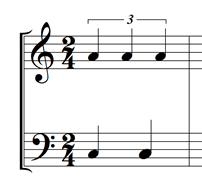Candidates were attracted to this question, but in spite of its attractiveness, candidates’ responses were not remarkable but averarge, this is due to candidates’ inadequate knowledge of African musical forms. They were expected to respond to the question in the following manners:
(a) Form in music is the orderly arrangement/structure/design of musical elements in time. Because music takes place in time, its form unfolds in time. Repetition and contrast are two fundamental characteristics of musical form, even in simple pieces.
(b) (i) Call and Response: A piece of music for a cantor (leader) and chorus. Antiphonal singing of solo singer answered by a chorus (group). Sometimes the part of the cantor is exactly responded to by the chorus. In some responsorial forms of music, the cantor exibits declamatory passages and alternates with the chorus.
(ii) Two-part form (AB): (it is also referred to as binary form) A musical composition in symmetrical halves; a vocal or instrumental form based on contrast (AB). A single musical form or plan is called AB. It consists of two divisions or sections, both normally founded on the same thematic material. A composition divided into two sections that gives a sense of statement (A) and counter statement (B).
(iii) Hocket: A technique or style whereby a melodic line or rhythmic pattern is shared among a number of voices or instruments. This is found in many African instrumental ensembles where segments of drum patterns are shared among members of the ensembles. Examples include Fontonfrom of the Akan (Ghana) and Gbedu of the Yoruba (Nigeria).
(iv) Hemiola: A vertical or horizontal combination of duple and triple metric groupings. The following are illustrations:
Vertical
 
Or/and
Horizontal
 
(v) Yodelling/Ululalation: A rapid alteration of high falsetto and low chest tones in singing. This is usually achieved by singers coming in at different intervals and shortening or lengthening a phrase and at certain points adding one or two extra notes to the main theme which is announced at the start of the performance.
(vi) Declamation: A style of singing in which the values are based largely on the tonal inflexions and rhythm of speech. It is usually achieved by free rhythm, that is the speech rhythm. It is also associated with the chant mode which is between speech and music
|



